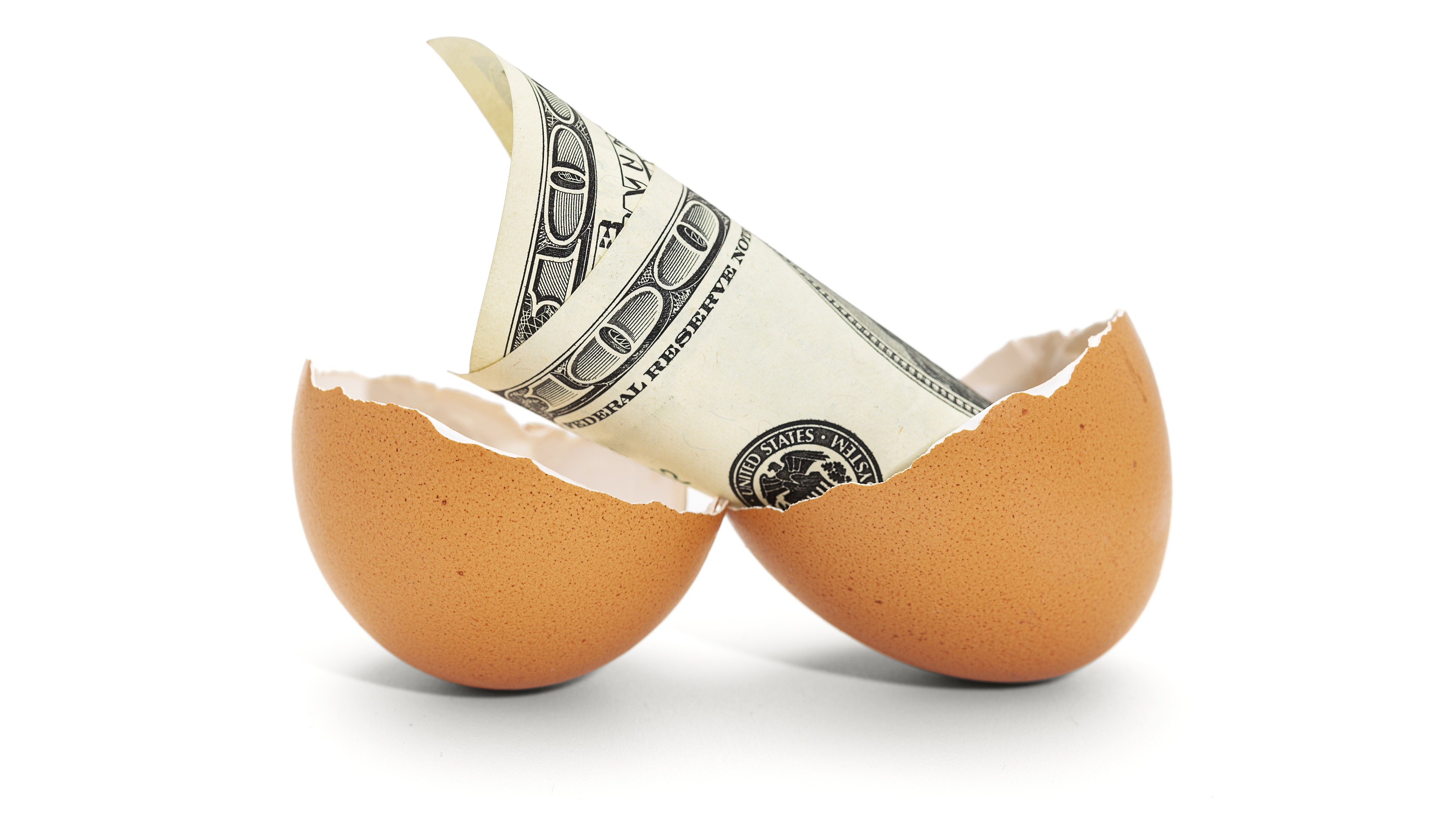Four Ways to Help Prevent a Market Downturn From Scrambling Your Nest Egg
You may not be able to avoid a market decline when you're newly retired and starting to rely on your nest egg for income, but you can plan for that risk.


A shaky stock market isn’t fun for any investor, no matter what age they might be. But if you’re nearing or new to retirement, a steep or prolonged market decline can have ramifications that go well beyond the initial hit to your portfolio.
If your retirement income plan requires you to pull money from your investment savings, the longevity of your nest egg could be significantly reduced — especially if your funds were depleted during a market downturn.
You’ll likely have to sell more of your assets to get the amount of cash you require for the short term, which means you’ll have fewer assets left in your portfolio to generate money for the long term.
From just $107.88 $24.99 for Kiplinger Personal Finance
Become a smarter, better informed investor. Subscribe from just $107.88 $24.99, plus get up to 4 Special Issues

Sign up for Kiplinger’s Free Newsletters
Profit and prosper with the best of expert advice on investing, taxes, retirement, personal finance and more - straight to your e-mail.
Profit and prosper with the best of expert advice - straight to your e-mail.
The Kiplinger Building Wealth program handpicks financial advisers and business owners from around the world to share retirement, estate planning and tax strategies to preserve and grow your wealth. These experts, who never pay for inclusion on the site, include professional wealth managers, fiduciary financial planners, CPAs and lawyers. Most of them have certifications including CFP®, ChFC®, IAR, AIF®, CDFA® and more, and their stellar records can be checked through the SEC or FINRA.
And if you’re at the start of what you expect to be a decades-long retirement, the consequences could be especially devastating.
Of course, you can’t be certain of what the market will do tomorrow, much less whether there might be a downturn in the months and years surrounding your planned retirement date.
But you can take steps to try to mitigate the potential impact of unlucky timing. Planning for what financial advisers refer to as “sequence of returns risk” can help you avoid one of the most serious — and often overlooked — risks to a confident retirement.
What is sequence of returns risk?
You’ve probably heard the saying “you can’t time the market” at some point in your investing journey. And it’s true. Even the most successful and informed investors can fail miserably when they try to predict what a certain stock or sector will do in the future.
But when you begin taking distributions from your retirement accounts, the timing, or “sequence,” in which you receive positive vs negative returns does matter.
If the market stays up and returns are positive, you can continue taking reasonably planned distributions without dramatically impacting the longevity of the portfolio.
But if the market experiences a sizable decline and you’re relying on your investments for income, your withdrawals will only compound your losses, quickly eroding your account value and increasing the likelihood that you could run out of money.
An example of what can happen
Here’s a basic, hypothetical example to give you an idea of how the sequence of your investment returns can impact your portfolio in retirement:
Let’s say two sisters retire with the same investment account balance of $100,000. Neither is contributing to her account any longer; instead, each sister is withdrawing $5,000 a year from her account.
Now suppose that over a 15-year period, both sisters experience the same average annual rate of return — but their returns occur in the opposite order.
Annie experiences three straight down years right at the beginning of her retirement, and despite several good years in the market later, she never really recovers from that initial setback. After 15 years, she has some money left, but she’s not sure it will be enough to last.
Barb is luckier –– she has a stronger start, with six straight years of positive returns. While Annie’s account value went down in the first years of her retirement, Barb’s money has had a chance to keep growing.
Looking for expert tips to grow and preserve your wealth? Sign up for Building Wealth, our free, twice-weekly newsletter.
And even though Barb had some down years, too, mostly at the end of those 15 years, she ends up with almost three times as much money in her account as her sister.
If Annie and Barb had not taken distributions from their portfolios, their balances after 15 years would have been exactly the same.
But because they were both relying on their investments for retirement income and taking regular withdrawals, their results were very different.
They both made and lost money, but the order in which each experienced those up-and-down years had a big impact.
How can you plan for sequence of returns risk?
Market volatility is scary. It’s also normal. Every downturn isn’t catastrophic, but if you’re old enough to be preparing for retirement, you’ve surely gone through a few rough patches with your investments. (There was the dotcom bubble in 2000, 9/11 in 2001, the Great Recession in 2008 and the COVID-19 pandemic in 2020, just to name a few.)
The difference now is that, as a recent retiree or soon-to-be retiree, you may not have time to wait for the market to recover. Which means proactive planning is critical.
Some strategies that could help you mitigate sequence of returns risk include:
No. 1: Reduce your exposure to volatility
If you haven’t already done so, this is a good time to talk to your financial adviser about moving to a more diversified portfolio mix that’s designed to preserve your hard-earned money.
Your adviser can stress-test your portfolio to see how it will hold up during a downturn, and you can discuss your changing tolerance for risk as you get older.
No. 2: Look at income-producing investments
If you’re planning to use your investments to help fund your retirement paycheck, you may want to switch at least a portion of your portfolio from a focus on returns to more reliable income producers.
This might include dividend-paying stocks, annuities or bonds.
No. 3: Build a bucket strategy
One way to help ensure you have enough to confidently cover your current needs while also growing funds for the future is to divide your savings and investments into different “buckets” based on when you’ll use the money.
One bucket, for example, could hold lower-risk and easy-to-access investments (think CDs and/or high-yield savings accounts) meant to fund the first years of your retirement.
Another bucket could include a mix of lower-risk and growth investments, such as mutual funds.
And a third bucket might hold a higher percentage of equities, designed to give you long-term growth.
The first two buckets could help keep your assets financially preserved if the market experiences a downturn during your early retirement years, while the investments in the third bucket would have time to recover from a downturn and still help provide for your later years.
No. 4: Consider a flexible withdrawal plan
It’s a good idea to know how much you’ll need to pull from your portfolio monthly or annually in retirement.
But if you can build in some flexibility — by giving yourself the option of temporarily taking less or skipping distributions during a downturn — you can potentially avoid selling at a loss at the start of your retirement.
Once you turn 73, however, you’ll have to take required minimum distributions (RMDs) if you have tax-qualified accounts, such as 401(k)s, 403(b)s and IRAs.
The key is to make the moves that ideally suit your needs before a dramatic market drop scrambles your nest egg.
Transitioning your investing focus from accumulation to preservation in the years before you plan to retire could make all the difference in how long your money lasts.
Kim Franke-Folstad contributed to this article.
The appearances in Kiplinger were obtained through a PR program. The columnist received assistance from a public relations firm in preparing this piece for submission to Kiplinger.com. Kiplinger was not compensated in any way.
Insurance products are offered through the insurance business Financial Services of America (FSA). Financial Services of America (FSA) is also a Financial Services practice that offers securities products and services through AE Financial Services, LLC (AEFS), member FINRA/SIPC. Financial Services of America (FSA) is also an Investment Advisory practice that offers investment advisory products and services through FSA Advisors (FSAA), a Registered Investment Advisor. AEFS and FSAA do not offer insurance products. The insurance products offered by Financial Services of America (FSA) are not subject to regulatory requirements and standards of care applicable to registered representatives and are not subject to investment advisory requirements. AEFS, FSAA and FSA are not affiliated companies.4538013-5/25
Related Content
- Markets Roller Coaster: Resist the Urge to Make Big Changes
- Four Historical Patterns in the Markets for Investors to Know
- Secure Your Retirement Paycheck: The Power of Three Buckets
- Six Financial Actions to Take the Year Before Retirement
- Tax Diversification: Smart Ways to Help Preserve Your Nest Egg
Profit and prosper with the best of Kiplinger's advice on investing, taxes, retirement, personal finance and much more. Delivered daily. Enter your email in the box and click Sign Me Up.

As supervisor of the Investment Advisory Division at Michigan-based Financial Services of America, Nick Shaheen helps ensure his firm’s clients receive tailored, high-quality advice to help them reach their financial goals. He is dedicated to helping others achieve a clear and confident retirement, and he takes pride in helping to simplify the planning process.
-
 Small Caps Hit a New High on Rate-Cut Hopes: Stock Market Today
Small Caps Hit a New High on Rate-Cut Hopes: Stock Market TodayOdds for a December rate cut remain high after the latest batch of jobs data, which helped the Russell 2000 outperform today.
-
 Is a New $25,000 Health Care Tax Deduction Coming in 2026?
Is a New $25,000 Health Care Tax Deduction Coming in 2026?Tax Policy A proposal from GOP Sen. Josh Hawley is adding to the chatter about health care affordability.
-
 Are You Middle-Class? Here's The Most Tax-Friendly State For Your Family
Are You Middle-Class? Here's The Most Tax-Friendly State For Your FamilyTax Tips We found the state with no income tax, low property tax bills, and exemptions on groceries and medicine.
-
 Small Caps Hit a New High on Rate-Cut Hope: Stock Market Today
Small Caps Hit a New High on Rate-Cut Hope: Stock Market TodayOdds for a December rate cut remain high after the latest batch of jobs data, which helped the Russell 2000 outperform today.
-
 What Investors May Face in the New Year: Interview
What Investors May Face in the New Year: InterviewKeith Lerner, the chief market strategist and chief investment officer for Truist Wealth, speaks with Kiplinger.
-
 My Adult Child Was Laid Off. Can We Discuss It Without Ruining the Holidays?
My Adult Child Was Laid Off. Can We Discuss It Without Ruining the Holidays?We asked mental health and financial experts for advice.
-
 3 Year-End Tax Strategies for Retirees With $2 Million to $10 Million
3 Year-End Tax Strategies for Retirees With $2 Million to $10 MillionTo avoid the OBBB messing up your whole tax strategy, get your Roth conversions and charitable bunching done by year's end.
-
 'Politics' Is a Dirty Word for Some Financial Advisers: 3 Reasons This Financial Planner Vehemently Disagrees
'Politics' Is a Dirty Word for Some Financial Advisers: 3 Reasons This Financial Planner Vehemently DisagreesYour financial plan should be aligned with your values and your politics. If your adviser refuses to talk about them, it's time to go elsewhere.
-
 For a Move Abroad, Choosing a Fiduciary Financial Planner Who Sees Both Sides of the Border Is Critical
For a Move Abroad, Choosing a Fiduciary Financial Planner Who Sees Both Sides of the Border Is CriticalWorking with a cross-border financial planner is essential to integrate tax, estate and visa considerations and avoid costly, unexpected liabilities.
-
 15 Costly Drugs Will Get Medicare Price Cuts in 2027: Will You Save?
15 Costly Drugs Will Get Medicare Price Cuts in 2027: Will You Save?The Centers for Medicare & Medicaid Services extended a safety net to older Americans by announcing significant price reductions on 15 high-cost prescription drugs, effective in 2027.
-
 UNH Sparks a 408-Point Surge for the Dow: Stock Market Today
UNH Sparks a 408-Point Surge for the Dow: Stock Market TodayThe best available data right now confirm both a slowing employment market and a December rate cut, a tension reflected at the equity index level.